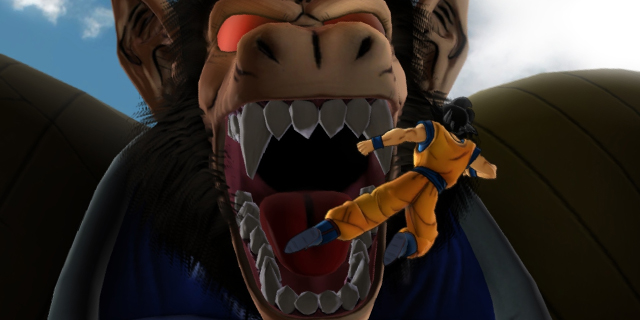
The appeal of fighting games is easy to see: formulate a better strategy than your opponent in single combat to win bragging rights, continued play, or the ability to advance the story. Fighters with simplified controls can still be fun (e.g., Nintendo’s Super Smash Bros. series), but they need a sense of fairness and reward to keep the player motivated.
Fighting games are heavily skill-based. You don’t just level up your guy to make fighting easier. You have to practice until you know his moves inside-out and can pull off an aerial block that cancels into a super with your eyes closed. Dragon Ball Z: Ultimate Tenkaichi, then, is not a fighting game. It’s an action game made out of a fighting game.
The fights in Ultimate Tenkaichi look great. They capture the feel of the anime perfectly. There are waves of energy, giant explosions, and huge boss encounters throughout the story mode. Where everything falls flat is actually playing those fights. Melee and ranged combat feel exactly the same, and the player is actively punished for doing well. Land enough hits in a row, and you’ll advance on your opponent automatically and engage in a clash.
Each combatant picks one of two options. If the choices differ, your attack lands, you damage your opponent, and the bout continues. If the choices match, your combo is broken, your opponent automatically lands a counterattack and the bout continues. The clash mechanic isn’t a terrible idea, but have it triggered by the attacker makes no sense. Clashes ought to be the potential outcome of a successful block which rewards the defender instead of a string of successful attacks which punish the attacker.
Signature moves, like regular combat, look impressive but are too easy to execute to feel rewarding. When one fighter loses enough health both fighters gain access to their spirit gauges. At this point clicking the right stick will unleash super attacks. There is a fundamental disconnect between performing a single button press and seeing your attack from orbit because that’s the only way to witness the entire explosion. Being on the receiving end of a super attack is one of the only times Ultimate Tenkaichi feels engaging.
When a super attack is coming your way, you are presented with three choices: block, evade, and intercept. Block lets the attack hit you at significantly reduced damage, and is the easiest to pull off. Evade lets you sidestep the attack and avoid damage altogether, and intercept lets you counter the attack and use your opponent’s energy against him. Intercepts are the most difficult to execute, and they come with the highest risk for failure since botching an intercept means taking more damage than just being hit with the attack.
The shallow, unrewarding combat makes all three play modes lackluster. Story mode has you playing pivotal battles from the Dragon Ball Z franchise as the main characters. There are standard fights, chase fights where you have to keep moving right to either avoid capture or catch up to your opponent, and boss fights where you take on towering enemies who all trade physical stature for a useful move set. It’s odd to see pattern-based bosses in a fighting game, and once you have the pattern down you’re unstoppable. Hero mode plays out like story mode except you take a character of your own creation through an alternate DBZ universe where your character is the center of every major fight.
Character creation options are limited, and odds are good that if you’re playing Ultimate Tenkaichi that you’d like to see the cut scenes taken from the show so hero mode probably isn’t where you’ll be spending a lot of your time. Multiplayer is better than the other two modes because a human opponent always feels better than a computer-controlled one, but the fighting system is still too shallow to feel rewarding even when you’re using it to take down a real person.
Dragon Ball Z: Ultimate Tenkaichi is all flash and no substance. It’s a shame, too. A show all about fighting should translate into a better game experience than this.
Pros: Fights are impressive to watch, special move defense is fun
Cons: Fights are generally boring to play, attackers are punished for playing well



















